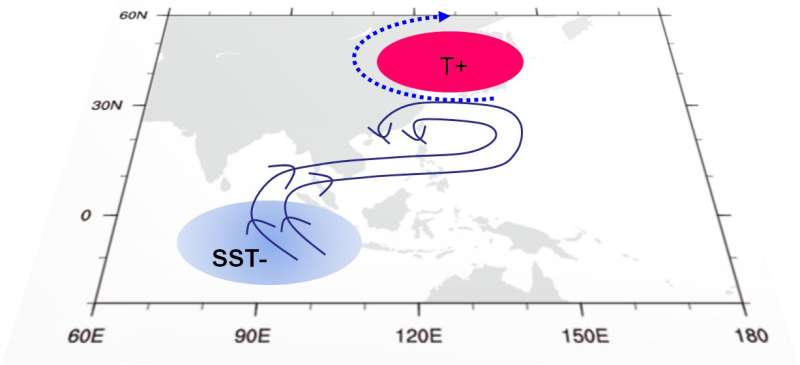Scientists discover the forces behind extreme heat over Northeast Asia

Against the background of global warming, extreme heat has occurred more frequently and caused adverse socioeconomic effects. In the midsummer of 2018, a severe extreme heat episode struck Northeast Asia, causing numerous fatalities. For instance, the extreme heat that struck Japan in July 2018 resulted in about 24,000 hospitalized patients and more than 90 deaths. To understand what caused the extreme heat over Northeast Asia, a scientific collaboration of climatologists examined the forces of the tropical circulation and sea surface temperature. Their results have recently been published in Atmospheric and Oceanic Science Letters.
"The extreme heat over Northeast Asia was caused by an anomalous anticyclone, which corresponded to the northwestward extension of the western North Pacific subtropical high and facilitated the occurrence of extreme heat via a subsidence anomaly," explains Ruidan Chen, the first author of the paper, who is an Associate Professor in the School of Atmospheric Sciences at Sun Yat-sen University in Guangzhou, China.
Chen also noted that the anomalous anticyclone over Northeast Asia was accompanied by a prominent cyclonic anomaly over the western North Pacific. "The cyclonic anomaly over the western North Pacific was accompanied by anomalous convection, which favored descending and anticyclonic anomalies over Northeast Asia through a local meridional cell," says Chen.
The researchers further discovered that cooling over the southeastern tropical Indian Ocean contributed to the above anomalous atmospheric circulation. "Cooling over the southeastern tropical Indian Ocean would have favored the cyclonic anomaly over the western North Pacific by triggering anomalous cross-equatorial flow and a local meridional cell," Chen explains.
The mechanism revealed by the case in 2018 also operates in climate statistics, verifying the robust influence of the southeastern tropical Indian Ocean. Considering the consistency of the sea surface temperature anomaly over this region, it could be a potential predictor for the climate over Northeast Asia.
More information: Ruidan CHEN et al, Influences of tropical circulation and sea surface temperature anomalies on extreme heat over Northeast Asia in the midsummer of 2018, Atmospheric and Oceanic Science Letters (2019). DOI: 10.1080/16742834.2019.1611170
Provided by Chinese Academy of Sciences




















